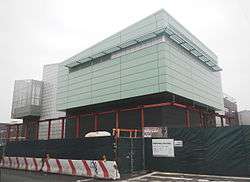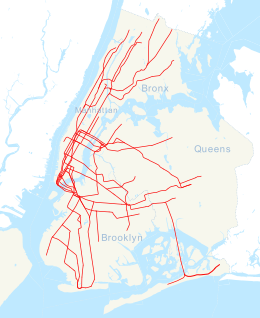Church Avenue (IND Culver Line)
| Church Avenue | |||||||
|---|---|---|---|---|---|---|---|
| New York City Subway rapid transit station | |||||||
|
| |||||||
| Station statistics | |||||||
| Address |
Church Avenue & McDonald Avenue Brooklyn, NY 11218 | ||||||
| Borough | Brooklyn | ||||||
| Locale | Kensington | ||||||
| Coordinates | 40°38′34.05″N 73°58′45.95″W / 40.6427917°N 73.9794306°WCoordinates: 40°38′34.05″N 73°58′45.95″W / 40.6427917°N 73.9794306°W | ||||||
| Division | B (IND) | ||||||
| Line | IND Culver Line | ||||||
| Services |
F G | ||||||
| Transit connections |
| ||||||
| Structure | Underground | ||||||
| Platforms |
2 island platforms cross-platform interchange | ||||||
| Tracks | 4 (2 in regular service) | ||||||
| Other information | |||||||
| Opened | October 7, 1933 | ||||||
| Accessible |
| ||||||
| Traffic | |||||||
| Passengers (2015) |
3,353,795[1] | ||||||
| Rank | 151 out of 422 | ||||||
| Station succession | |||||||
| Next north |
Fort Hamilton Parkway (local): F Seventh Avenue (express): no regular service | ||||||
| Next south |
Ditmas Avenue (local): F 18th Avenue (express): no regular service (Terminal): G | ||||||
|
| |||||||
| Next |
Queens Plaza (via Crosstown): no regular service Jay Street–MetroTech (via Culver): F | ||||||
| Next |
Coney Island–Stillwell Avenue: F none: G | ||||||
| |||||||
| |||||||
Church Avenue is an express station on the IND Culver Line of the New York City Subway. Located at Church and McDonald Avenues in Kensington, Brooklyn, it is served by the F and G trains at all times, the latter of which terminates here.
Station layout
| G | Street Level | Exit/Entrance |
| M | Mezzanine | Fare control, station agent |
| P Platform level |
Northbound local | ← ← |
| Northbound express | ← No regular service (No service: Seventh Avenue) | |
| Southbound express | No regular service (No service: 18th Avenue) | |
| Southbound local | | |
This underground station, opened on October 7, 1933, has four tracks and two island platforms. The two center express tracks are not normally used in revenue service.
Both outer track walls have a maroon trim line with a Tuscan red border and small signs below them reading "CHURCH" in white lettering on a black background. This tile band is set in a two-tile-high course, an arrangement normally seen at local stations. All i-beam columns in the station are colored Hunter green. The station signs are in the standard black name plates with white lettering.
There is a four track yard south of the station beneath the revenue tracks, which is used for storing and turning G trains.[2][3] South of the connection to the yard, the line ramps up to become a three track elevated line (with the express tracks merging into one track, with switches from the express to the local tracks in the respective directions) before entering Ditmas Avenue station.[4]
Entrances and exits
This station has a full length mezzanine above the platforms and tracks with two fare control areas. The full-time one is at the extreme south end. Two staircases and one elevator from each platform go up to the mezzanine, where public restrooms at the center are available and a turnstile bank provides entrance/exit to/from the station. Outside fare control, there is a token booth and staircases going up to all four corners of Church and McDonald Avenues.[5] There is also a ramp leading to an elevator that goes up to the west side of Church Avenue. The three elevators, installed during a 2008 renovation, make the station ADA accessible.[6]
The station's other fare control area at the north end is un-staffed. Three staircases from each platform go up to a mezzanine, where exit-only and High Entry/Exit Turnstiles provide entrance/exit to/from the station. Outside fare control, there are two staircases facing in different directions that go up to either southern corners of Albemarle Road and McDonald Avenues.[5] Crew facilities at the center of the mezzanine separate the two fare control areas.
Miscellaneous

.jpg)
This station is often used for shooting subway scenes for television shows and movies as the long mezzanine can be used for setting up production and the express tracks can be used for staging subway cars without interfering with normal service.[3]
On December 28, 1949, New Zealand athlete Jack Lovelock fell onto the tracks at this station after complaining about dizziness to his wife. He was then killed by an oncoming train.
In 1958, there was a program in which subway riders could get their clothes ironed at the station for a fee.[7]
On August 2, 1974, a robbery suspect was killed by a plainclothes police officer in the station. The former was suspected to have robbed a token booth in the station shortly beforehand.[8]
References
- ↑ "Facts and Figures: Annual Subway Ridership". Metropolitan Transportation Authority. Retrieved 2016-04-19.
- ↑ "Church Avenue Subway Yard". ltvsquad.com. LTV Squad. November 23, 2015. Retrieved 23 November 2015.
- 1 2 "Hollywood Underground: The Art of Making Movies in The New York City Subway". Metropolitan Transportation Authority. Retrieved 16 August 2015.
- ↑ Marrero, Robert (2015-09-13). "469 Stations, 846 Miles" (PDF). B24 Blog, via Dropbox. Retrieved 2015-10-09.
- 1 2 "MTA Neighborhood Maps: Borough Park" (PDF). mta.info. Metropolitan Transportation Authority. 2015. Retrieved 19 July 2015.
- ↑ "MTA NYC Transit Opens ADA Elevators at Church Avenue F Station in Brooklyn" (Press release). Metropolitan Transportation Authority. July 7, 2008. Retrieved 2008-07-09.
- ↑ "IND RIDERS TO GET CLEANING SERVICE". The New York Times. 1958-07-02. Retrieved 2016-07-15.
- ↑ "Suspect Killed in IND Station Holdup". The New York Times. 1974-08-02. Retrieved 2016-07-15.
External links
| Wikimedia Commons has media related to Church Avenue (IND Culver Line). |
- nycsubway.org – IND Crosstown: Church Avenue
- Station Reporter — F Train
- The Subway Nut — Church Avenue – Kensington Pictures
- Church Avenue entrance from Google Maps Street View
- Albemarle Road entrance from Google Maps Street View
- mezzanine from Google Maps Street View
- Joseph Brennan, "Abandoned Stations"



